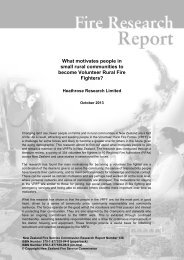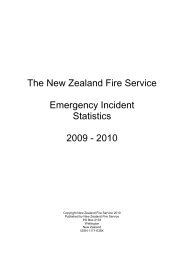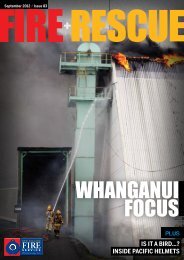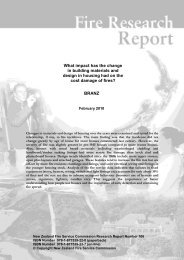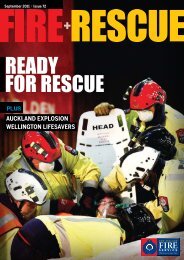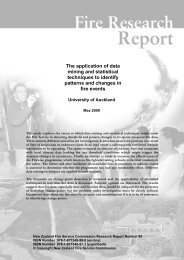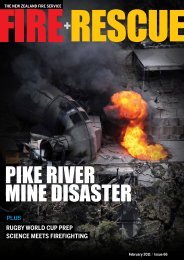Emergency Incident Statistics 2010-2011 - New Zealand Fire Service
Emergency Incident Statistics 2010-2011 - New Zealand Fire Service
Emergency Incident Statistics 2010-2011 - New Zealand Fire Service
Create successful ePaper yourself
Turn your PDF publications into a flip-book with our unique Google optimized e-Paper software.
How is the <strong>Emergency</strong> <strong>Incident</strong> <strong>Statistics</strong> publication produced?<br />
<strong>Emergency</strong> <strong>Incident</strong> <strong>Statistics</strong><br />
The SMS <strong>Incident</strong> System is a dynamic database, which means that emergency incident information can<br />
be updated/edited at any time.<br />
Before creating this publication, the data is copied to a "holding area" and stored for historical purposes.<br />
This procedure is similar to a Census, as it provides us with a "snapshot" of our emergency incident<br />
information at that particular time.<br />
This data cube is then searched using specialised software, which produces the tables contained in this<br />
publication.<br />
The date of publication is generally aimed to be shortly after the end of the financial year (30 June),<br />
however the tables are not assembled until the database reaches a level of 99% completion. The<br />
completion level is derived from the total number of incidents in the most recent year, and the number of<br />
incident reports that are outstanding.<br />
The NZFS is committed to ensuring that the data that is contained in its databases is as error-free as<br />
possible. As a result, we monitor and perform quality assurance checks to ensure that the level of humanerror<br />
is as low as possible. When errors are found, they are corrected by our administration staff who<br />
liase with operational firefighters to ensure that the data represents real world events as close as<br />
possible.<br />
As a result of quality assurance, some information may change over the course of producing this<br />
publication, which would increase the difficulty of producing statistics from a dynamic database. The<br />
snapshot method helps to avoid such problems. Tables in this publication which are recreated as "ad hoc<br />
queries" may not match historical publications, because ad hoc queries are run through (essentially) our<br />
"live" database.<br />
We are always looking for new and innovative ways to present our information to you, and should you<br />
require more information regarding how the publication is produced, or would like to make comments,<br />
please feel free to contact us at the following email address:<br />
SMSADMIN@fire.org.nz<br />
<strong>New</strong> <strong>Zealand</strong> <strong>Fire</strong> <strong>Service</strong> Production



